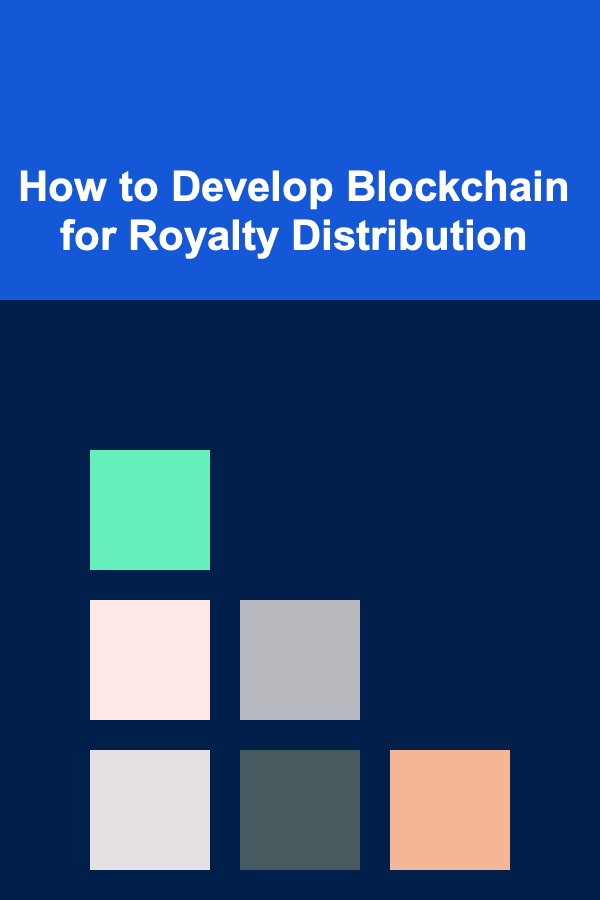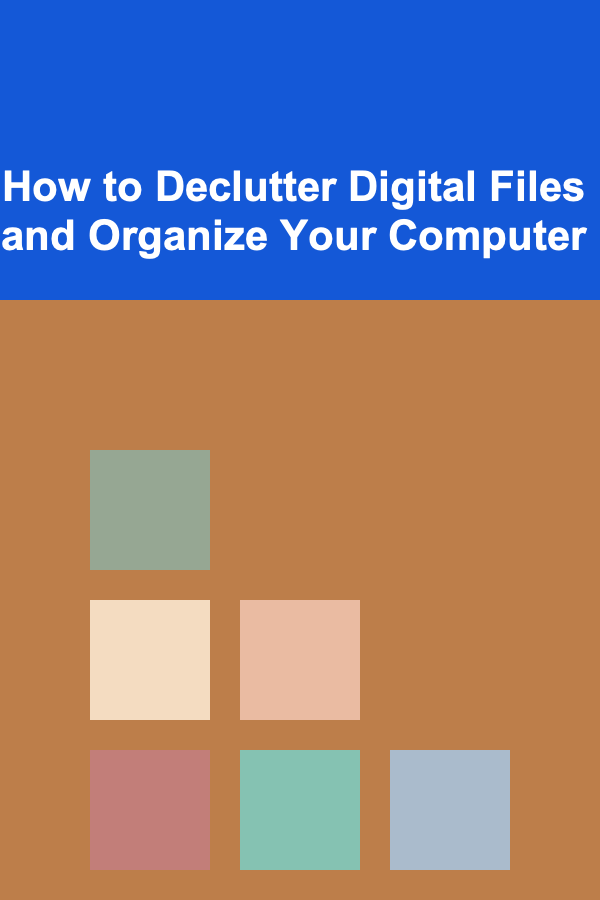
How to Develop Blockchain for Royalty Distribution
ebook include PDF & Audio bundle (Micro Guide)
$12.99$5.99
Limited Time Offer! Order within the next:

The rise of blockchain technology has created a revolutionary way of handling digital transactions, providing a secure, transparent, and decentralized method for various sectors. Among these sectors, the creative industries, including music, art, literature, and film, have been exploring blockchain's potential to address longstanding issues in royalty distribution. In this article, we will explore the steps involved in developing a blockchain-based royalty distribution system, examine its benefits, and discuss the key components that need to be considered when creating such a platform.
The Problem of Royalty Distribution
In traditional royalty distribution models, intermediaries, such as record labels, publishers, distributors, and other third parties, handle the collection and disbursement of royalties. This process is often opaque, slow, and inefficient, leading to a lack of transparency, delayed payments, and even disputes over royalty shares. Additionally, creators frequently receive only a small percentage of the total revenue generated by their work, with much of it being absorbed by these intermediaries.
Blockchain technology offers a solution by enabling direct, peer-to-peer transactions between content creators and consumers. With its decentralized and immutable nature, blockchain ensures that royalty distribution is transparent, efficient, and secure, reducing the need for intermediaries and providing fair compensation to creators.
Understanding Blockchain Technology
Blockchain is a decentralized, distributed ledger system that records transactions across multiple computers in such a way that the record cannot be altered retroactively. This makes blockchain an ideal solution for applications that require transparency, security, and immutability, such as royalty distribution.
A blockchain consists of a chain of blocks, each containing a list of transactions. Every block is linked to the previous one through a cryptographic hash, ensuring that the data cannot be tampered with. Because the blockchain is distributed across multiple nodes (computers), it is virtually impossible for any single party to alter the data without the consensus of the network.
Key Components of a Blockchain-based Royalty Distribution System
Developing a blockchain-based royalty distribution system requires careful planning and consideration of several key components. These components will ensure that the platform operates effectively, efficiently, and in a way that is beneficial to all stakeholders, from content creators to consumers.
1. Smart Contracts
Smart contracts are self-executing contracts with the terms of the agreement directly written into code. In the context of royalty distribution, smart contracts can automate the process of royalty payments based on predefined rules, such as the percentage share of each stakeholder involved in the creation and distribution of content. Smart contracts can trigger royalty payments whenever a transaction occurs, ensuring that creators are paid instantly and transparently.
For example, if a song is sold, a smart contract can automatically distribute the royalties to the artist, producer, and any other stakeholders according to their agreed-upon shares. This eliminates the need for intermediaries and ensures that payments are made promptly and accurately.
2. Tokenization of Royalty Shares
Tokenization refers to the process of converting ownership rights or assets into digital tokens on the blockchain. In a royalty distribution system, tokenization can be used to represent shares of ownership in a creative work, such as a song, artwork, or film. These tokens can then be traded or distributed to the relevant parties according to the terms of the royalty agreement.
For instance, if an artist releases a song, they could tokenize their royalty rights, creating a certain number of tokens that represent their share of the royalties. These tokens can be distributed to the artist, producers, and other contributors based on their ownership percentage. This system provides a transparent and verifiable way of tracking ownership and royalty distribution.
3. Decentralized Applications (DApps)
A Decentralized Application (DApp) is an application that runs on a decentralized network, such as a blockchain, rather than a centralized server. In the case of royalty distribution, a DApp can be developed to enable creators to register their works, set up royalty distribution rules, and track payments in real-time.
DApps can provide a user-friendly interface for creators and other stakeholders, allowing them to interact with the blockchain without needing to understand the underlying technical details. For example, a musician could use a DApp to upload their song, set the royalty distribution parameters, and receive payments directly into their wallet whenever the song is sold or streamed.
4. Digital Wallets and Payments
To facilitate royalty payments, a blockchain-based royalty distribution system needs a secure and reliable digital wallet solution. Wallets are used to store cryptocurrencies and tokens, and they enable users to send and receive payments on the blockchain. In the context of royalty distribution, creators, publishers, and other stakeholders would need to set up wallets to receive their royalties.
Payments can be made in cryptocurrency or tokenized assets, and they can be programmed to occur automatically when certain conditions are met, such as the sale or streaming of a creative work. Blockchain's transparency ensures that all transactions are visible to all participants, reducing the risk of fraud or disputes.
5. Oracles for External Data Integration
Blockchain networks operate within a closed system, meaning they cannot directly access external data. However, for a royalty distribution system to function properly, it needs to be able to track events such as the sale or streaming of content, which occur outside the blockchain. This is where oracles come into play.
Oracles are trusted data providers that feed external information into the blockchain. For example, an oracle could provide data about music streams from a platform like Spotify or Apple Music, enabling the smart contract to trigger royalty payments when a song is streamed. By integrating oracles, blockchain-based royalty distribution systems can access real-world data, making the process fully automated and efficient.
Step-by-Step Guide to Developing a Blockchain for Royalty Distribution
Developing a blockchain-based royalty distribution system involves several key steps. Below is a step-by-step guide to help developers and organizations create such a platform:
Step 1: Define the Problem and Objectives
Before starting the development process, it is essential to define the problem that the blockchain system will solve and the objectives of the platform. The primary objective of a blockchain-based royalty distribution system is to ensure transparency, reduce intermediaries, and automate the payment process for creators.
Other objectives could include enabling fractional ownership, reducing transaction fees, and providing real-time tracking of royalties. It is also important to consider the scalability of the system and the potential for integrating with existing platforms in the creative industries.
Step 2: Choose the Right Blockchain Platform
There are several blockchain platforms that can be used to develop a royalty distribution system. The choice of platform depends on factors such as scalability, cost, and compatibility with existing systems. Ethereum is one of the most popular blockchain platforms for developing decentralized applications and smart contracts, but other platforms such as Binance Smart Chain, Solana, or Polkadot may also be suitable depending on the specific requirements.
Step 3: Develop Smart Contracts
The core functionality of a blockchain-based royalty distribution system relies on smart contracts. Developers will need to write smart contracts that define the terms of the royalty agreement, including the distribution rules, the percentage shares of each stakeholder, and the conditions for triggering payments.
Smart contracts should be written in a language like Solidity (for Ethereum) and tested thoroughly to ensure that they function as expected. It is also crucial to audit the smart contracts to identify potential security vulnerabilities.
Step 4: Implement Tokenization
To represent ownership and royalty shares, developers will need to implement a tokenization mechanism. This involves creating a token standard (such as ERC-20 or ERC-721 on Ethereum) that allows the creation and distribution of digital tokens that represent ownership in a creative work.
Tokenized royalties can be distributed to stakeholders according to the terms of the smart contract, and these tokens can be traded or transferred as needed.
Step 5: Build the DApp Interface
The DApp interface is the frontend through which users will interact with the blockchain. The DApp should provide an intuitive and user-friendly interface for creators, producers, and other stakeholders to upload content, set up royalty distribution rules, and track payments.
The DApp should be accessible via web or mobile platforms, and it should integrate with digital wallets to facilitate payments. Additionally, the DApp should be designed to ensure that users can easily access relevant data, such as transaction history and royalty earnings.
Step 6: Integrate Oracles
To provide real-time data about sales, streams, or other relevant events, the system must integrate oracles. These oracles can be programmed to pull data from external platforms, such as music streaming services or digital marketplaces, and feed it into the blockchain to trigger smart contract actions.
Developers should ensure that the oracles are reliable and secure to maintain the integrity of the system.
Step 7: Test and Launch
Once the system is developed, it is crucial to test it thoroughly before launching. Testing should include both functional testing (to ensure that the system works as expected) and security testing (to identify vulnerabilities in the blockchain, smart contracts, and DApp).
After testing, the platform can be deployed to a live blockchain network, and creators can begin using it to manage their royalty distribution.
Benefits of Blockchain for Royalty Distribution
A blockchain-based royalty distribution system offers several advantages over traditional methods, including:
- Transparency: All transactions are recorded on a public ledger, making it easy for creators to track their royalties in real-time.
- Efficiency: Smart contracts automate the royalty distribution process, reducing the need for intermediaries and speeding up payments.
- Fairness: Blockchain ensures that creators are paid fairly, as the system enforces predetermined royalty shares without manipulation.
- Security: Blockchain's cryptographic nature ensures that payments are secure and tamper-proof.
Conclusion
Developing a blockchain-based royalty distribution system is a complex but highly rewarding task that can transform the creative industries. By using smart contracts, tokenization, decentralized applications, and oracles, it is possible to create a transparent, efficient, and secure platform for royalty distribution. This system not only benefits creators by ensuring they receive fair compensation but also enhances trust and accountability within the entire industry. With the right approach, blockchain can revolutionize how royalties are managed and distributed across the globe.

Be Unforgettable: How to Use Memory Triggers to Stand Out
Read More
How to Declutter Digital Files and Organize Your Computer
Read More
How to Store Cleaning Supplies in Small Spaces
Read More
How to Use Color Psychology in Your Holiday Decor
Read More
Navigating the Dental Practice: Collaboration and Communication with Dentists
Read More
How to Write Travel Guides with ChatGPT
Read MoreOther Products

Be Unforgettable: How to Use Memory Triggers to Stand Out
Read More
How to Declutter Digital Files and Organize Your Computer
Read More
How to Store Cleaning Supplies in Small Spaces
Read More
How to Use Color Psychology in Your Holiday Decor
Read More
Navigating the Dental Practice: Collaboration and Communication with Dentists
Read More